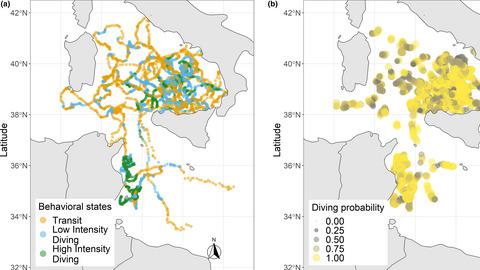当前位置:
X-MOL 学术
›
Ecol. Evol.
›
论文详情
Our official English website, www.x-mol.net, welcomes your
feedback! (Note: you will need to create a separate account there.)
Movement patterns of large juvenile loggerhead turtles in the Mediterranean Sea: Ontogenetic space use in a small ocean basin.
Ecology and Evolution ( IF 2.3 ) Pub Date : 2020-07-02 , DOI: 10.1002/ece3.6370 Marianna Chimienti 1 , Monica F Blasi 2 , Sandra Hochscheid 3
Ecology and Evolution ( IF 2.3 ) Pub Date : 2020-07-02 , DOI: 10.1002/ece3.6370 Marianna Chimienti 1 , Monica F Blasi 2 , Sandra Hochscheid 3
Affiliation

|
Mechanisms that determine how, where, and when ontogenetic habitat shifts occur are mostly unknown in wild populations. Differences in size and environmental characteristics of ontogenetic habitats can lead to differences in movement patterns, behavior, habitat use, and spatial distributions across individuals of the same species. Knowledge of juvenile loggerhead turtles' dispersal, movements, and habitat use is largely unknown, especially in the Mediterranean Sea. Satellite relay data loggers were used to monitor movements, diving behavior, and water temperature of eleven large juvenile loggerhead turtles (Caretta caretta ) deliberately caught in an oceanic habitat in the Mediterranean Sea. Hidden Markov models were used over 4,430 spatial locations to quantify the different activities performed by each individual: transit, low‐, and high‐intensity diving. Model results were then analyzed in relation to water temperature, bathymetry, and distance to the coast. The hidden Markov model differentiated between bouts of area‐restricted search as low‐ and high‐intensity diving, and transit movements. The turtles foraged in deep oceanic waters within 60 km from the coast as well as above 140 km from the coast. They used an average area of 194,802 km2, where most individuals used the deepest part of the Southern Tyrrhenian Sea with the highest seamounts, while only two switched to neritic foraging showing plasticity in foraging strategies among turtles of similar age classes. The foraging distribution of large juvenile loggerhead turtles, including some which were of the minimum size of adults, in the Tyrrhenian Sea is mainly concentrated in a relatively small oceanic area with predictable mesoscale oceanographic features, despite the proximity of suitable neritic foraging habitats. Our study highlights the importance of collecting high‐resolution data about species distribution and behavior across different spatio‐temporal scales and life stages for implementing conservation and dynamic ocean management actions.
中文翻译:

地中海大型幼年红海龟的运动模式:小洋盆的个体发育空间利用。
决定个体发生栖息地转变如何、何地以及何时发生的机制在野生种群中大多是未知的。个体发生栖息地的大小和环境特征的差异可能导致同一物种个体之间的运动模式、行为、栖息地利用和空间分布的差异。关于幼年红海龟的扩散、活动和栖息地利用的知识在很大程度上是未知的,特别是在地中海。卫星中继数据记录仪被用来监测在地中海海洋栖息地故意捕获的 11 只大型红海龟幼年龟 ( Caretta caretta ) 的运动、潜水行为和水温。隐马尔可夫模型用于超过 4,430 个空间位置来量化每个人进行的不同活动:中转、低强度和高强度潜水。然后根据水温、测深和距海岸的距离对模型结果进行分析。隐马尔可夫模型将区域限制搜索的次数区分为低强度和高强度潜水以及过境运动。海龟在距海岸60公里以内以及距海岸140公里以上的深海水域觅食。它们使用的平均面积为 194,802 km 2 ,其中大多数个体使用南第勒尼安海最深的部分和最高的海山,而只有两个转向浅海觅食,这表明相似年龄级别的海龟在觅食策略上具有可塑性。 第勒尼安海大型幼年红海龟(包括一些最小体型的成年红海龟)的觅食分布主要集中在具有可预测的中尺度海洋学特征的相对较小的海洋区域,尽管靠近合适的浅海觅食栖息地。我们的研究强调了收集不同时空尺度和生命阶段的物种分布和行为的高分辨率数据对于实施保护和动态海洋管理行动的重要性。
更新日期:2020-07-30
中文翻译:

地中海大型幼年红海龟的运动模式:小洋盆的个体发育空间利用。
决定个体发生栖息地转变如何、何地以及何时发生的机制在野生种群中大多是未知的。个体发生栖息地的大小和环境特征的差异可能导致同一物种个体之间的运动模式、行为、栖息地利用和空间分布的差异。关于幼年红海龟的扩散、活动和栖息地利用的知识在很大程度上是未知的,特别是在地中海。卫星中继数据记录仪被用来监测在地中海海洋栖息地故意捕获的 11 只大型红海龟幼年龟 ( Caretta caretta ) 的运动、潜水行为和水温。隐马尔可夫模型用于超过 4,430 个空间位置来量化每个人进行的不同活动:中转、低强度和高强度潜水。然后根据水温、测深和距海岸的距离对模型结果进行分析。隐马尔可夫模型将区域限制搜索的次数区分为低强度和高强度潜水以及过境运动。海龟在距海岸60公里以内以及距海岸140公里以上的深海水域觅食。它们使用的平均面积为 194,802 km 2 ,其中大多数个体使用南第勒尼安海最深的部分和最高的海山,而只有两个转向浅海觅食,这表明相似年龄级别的海龟在觅食策略上具有可塑性。 第勒尼安海大型幼年红海龟(包括一些最小体型的成年红海龟)的觅食分布主要集中在具有可预测的中尺度海洋学特征的相对较小的海洋区域,尽管靠近合适的浅海觅食栖息地。我们的研究强调了收集不同时空尺度和生命阶段的物种分布和行为的高分辨率数据对于实施保护和动态海洋管理行动的重要性。











































 京公网安备 11010802027423号
京公网安备 11010802027423号